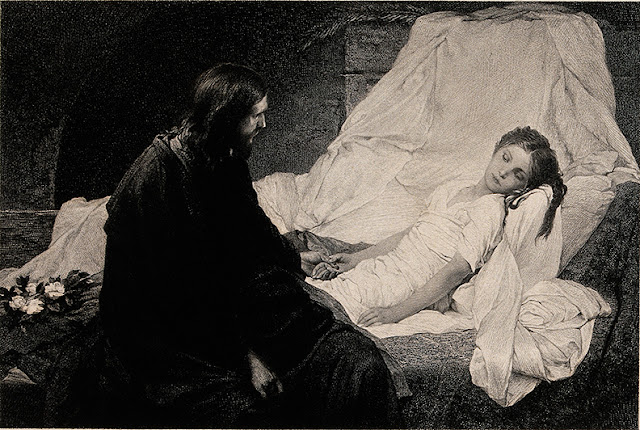MARK 3:1-6
Jesus enters the synagogue and heals a man's withered hand while the Pharisees move toward final judgment.
(Read it here.) Once again it comes down to the nitpicking details the Pharisees labeled holiness. Somehow "healing" just doesn't fall under the "work" label for me (although if I were a doctor or nurse that would be a whole other kettle of beans.) The Pharisees had no such qualms. This is easy to see when you know how stringent the rules were about medical care on the Sabbath.
That also makes it all the easier to see why Jesus' pulling that man to the front, asking that question, and then healing him was such an in-your-face challenge. Gotta love it, don't you? He just never backed down from the good fight. He never quit trying to get them to
understand what they were doing that was wrong.
Jesus' opponents take for granted that he is able to cure and they guess, rightly, that the sight of the disabled man will move him to do so. But their only interest is in whether he will again violate their interpretation of sabbath law.
[...]
Far from being intimidated by their scrutiny, Jesus ensures that what he is about to do will be in full public view. The verb for come up, egeiro, can also be translated "rise up," and is the same word used for Jesus' resurrection in 16:6. Mark often uses it in healing stories (1:31; 2:9-12; 5:41; 10:49) to indicate that Jesus is bringing about not only physical cures but a restoration to fullness of life.
[...]
Unlike Matthew and Luke, Mark gives us a glimpse of Jesus'' interior reaction: he is angry and deeply grieved at their hardness of heart. "Hardness of heart" signifies a stubborn refusal to be open to God (Jer 11:8; Ezek 3:7; Eph 4:18) ...
At Jesus' word, the man stretches out his crippled hand, and in this very act it is restored. The Pharisees' response to this deed of mercy is swift. Ironically, they answer Jesus' question by their actions: rather than choosing to do good on the sabbath, they choose to do evil and destroy life by conspiring to put him to death. ...
George Montague, Catholic Commentary on Sacred Scripture: Gospel of Mark
Jewish rules about healing and the Sabbath.
It was the Sabbath day; all work was forbidden and to heal was work. The Jewish law was definite and detailed about this. Medical attention could be given only if a life was in danger. To take some examples -- a woman in childbirth might be helped on the Sabbath; an infection of the throat might be treated; if a wall fell on anyone, enough might be cleared away to see whether he was dead or alive; if he was alive he might be helped, if he was dead the body must be left until the next day. A fracture could not be attended to. Cold water might no be poured on a sprained hand or foot. A cut finger might be bandaged with a plain bandage but not with ointment. That is to say, at the most an injury could be kept from getting worse; it must not be made better...
Jesus knew that. This man's life was not in the least danger. Physically he would be no worse off if he were left until tomorrow. For Jesus this was a test case, and he met it fairly and squarely. He told the man to rise and to come out of his place and stand where everyone could see him. There were probably two reasons for that. Very likely Jesus wished to make one last effort to waken sympathy for the stricken man by showing everyone his wretchedness. Quite certainly Jesus wished to take the step he was going to take in such a way that no one could possibly fail to see it.
Possible historical precedents cited by Jesus.
Jesus may allude to the precedent of 1 Macc 2:41, where the Jews temporarily suspended Sabbath observance to permit defensive warfare. This was necessary in order to save life from military attacks on their sacred day of rest. If Israel could sidestep the Sabbath to preserve life, then surely Jesus can heal a man's hand on the same day.
=====
Sources and Notes Index






_-_James_Tissot.jpg)






.jpg)





